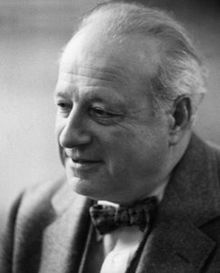Walter Piston’s Second Symphony, written in 1943, is one of those mid-twentieth century American musical gems that deserves to be heard more often. Following its National Symphony Orchestra premiere in March, 1944, conductor Hans Kindler declared that the symphony,
is without even the shadow of a doubt one of the half dozen great works written during the last ten years. It sings forever in my heart and in my consciousness, and it does not want to leave me.

A year later, the work was performed by the Boston Symphony, NBC Symphony and New York Philharmonic. But, with the exception of a few recordings, it has fallen largely off the radar.
The unfair perception of Walter Piston as a dry, Ivy League academic and later a twelve tone composer (as heard in his Eighth Symphony) may be partly to blame. Born in Rockland, Maine in 1894, Piston served for many years on the faculty of Harvard University. His students included Leroy Anderson, Leonard Bernstein, Elliott Carter, John Harbison, and Daniel Pinkham. As a music theorist he is remembered as the author of a series of respected textbooks: Principles of Harmonic Analysis, Counterpoint, Orchestration, and Harmony. Aaron Copland described Piston as, “one of the most expert craftsmen American music can boast.” But as conductor Gerard Schwarz noted, with the advantage of hindsight, Piston’s music goes beyond craft:
In some ways Piston was the dean of American music. But as a result of his intellect and his association with the university environment, he was considered to be a somewhat dull, academic composer. For anyone familiar with Piston’s music, it is clear that he is neither dull nor academic, but incredibly imaginative and innovative. It is true that he uses classic forms, but with his own language. I have studied most of his output and I have come to realize that he was a master, an inspired composer.
Beyond a neoclassical structural purity, the Second Symphony doesn’t conform easily to any distinct stylistic category. At moments it may remind you of the sonorous chorale-like orchestration of Piston’s German contemporary, Paul Hindemith. As with Hindemith, who could play almost every instrument and wrote a wide array of sonatas, Piston had a deep understanding of orchestration. “I’ve always composed music from the point of view of the performers” he said. As the second symphony unfolds, it’s easy to sense the instruments coming to life, suggesting distinct personas. At times, they engage in a soulful conversation (as in the second movement’s lamenting dialogue between the clarinet and flute).
As Carol J. Oja points out in this article, Piston was an “internationalist” who did not actively seek to develop a distinctly “American” musical style. But there are moments in the Second Symphony when it’s easy to catch a hint of the blues. Additionally, there’s a feeling of Ragtime swing in the spunky melody that pops up around the 2:00 mark in the first movement. The fugal counterpoint that follows sparkles with a fresh, innocent mid-century American vibe. Despite these lighthearted adventures, the first movement ends with a solemn brass chorale, sinking back into the atmosphere the music seemed to be trying to escape in the opening.
The second movement emerges out of a single horn tone. A lonely bassoon line spins into a short canon in thirds with the low strings. By the time the clarinet begins its soulful, extended statement, we already have a sense that the music is striving, reaching higher towards some unknown goal. The flute picks up where the clarinet leaves off, taking the conversation to a new level of intensity. The movement alternates between collective anguish and serene beauty (listen to the glistening violin entrance at 15:30).
Here is Gerard Schwarz’s recording with the Seattle Symphony, originally released on the Delos Records label in 1992:
[ordered_list style=”decimal”]
- Moderato 0:00
- Adagio 10:07
- Allegro 21:51
[/ordered_list]
[unordered_list style=”tick”]
[/unordered_list]
Additional Links
[unordered_list style=”tick”]
- View the New York Philharmonic’s score to Piston’s Symphony No. 2 with Leonard Bernstein’s markings.
- Listen to the Seattle Symphony’s recordings of Walter Piston’s Fourth, Fifth, and Sixth Symphonies.
[/unordered_list]
